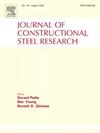Experimental investigation on slender concrete-filled double-skin corrugated steel tubes under eccentric compression
IF 4
2区 工程技术
Q1 CONSTRUCTION & BUILDING TECHNOLOGY
引用次数: 0
Abstract
Concrete-filled double-skin thin-walled corrugated steel tubes (CFDCSTs) are novel hollow section composite members consisting of outer and inner galvanized corrugated steel tubes (CSTs) with sandwiched reinforced concrete. They have shown great applicability in scenarios such as bridge piers and exposed beam-columns in buildings. While the failure modes, working mechanisms, and load-bearing capacities of short CFDCST members have been studied, their stability performance requires further investigation. Therefore, thirteen large-scale slender CFDCST specimens with effective lengths of 2763 mm and 4263 mm were prepared and tested under eccentric compression in the study. The test variables were the slenderness ratio, eccentricity ratio, hollow ratio, outer CST thickness, and longitudinal reinforcement ratio. The test results indicated that CFDCST specimens failed in a ductile mode and exhibited desirable mechanical performance. As the hollow ratio increased, the bearing capacity decreased while the ductility index increased; the reduction in bearing capacity was less pronounced as the eccentricity ratio and slenderness ratio increased. The thin-walled outer CSTs provided effective confinement, while the thin-walled inner CSTs offered sufficient internal support. Finally, existing design models were modified based on the test results, and their applicability for slender CFDCST members was validated.
求助全文
约1分钟内获得全文
求助全文
来源期刊

Journal of Constructional Steel Research
工程技术-工程:土木
CiteScore
7.90
自引率
19.50%
发文量
550
审稿时长
46 days
期刊介绍:
The Journal of Constructional Steel Research provides an international forum for the presentation and discussion of the latest developments in structural steel research and their applications. It is aimed not only at researchers but also at those likely to be most affected by research results, i.e. designers and fabricators. Original papers of a high standard dealing with all aspects of steel research including theoretical and experimental research on elements, assemblages, connection and material properties are considered for publication.
 求助内容:
求助内容: 应助结果提醒方式:
应助结果提醒方式:


